Swallows and martins are some of the most graceful and fascinating birds you can spot in Tennessee. These agile flyers brighten the skies from spring through summer, showcasing their stunning colors and impressive aerial skills. If you enjoy birdwatching or want to learn more about Tennessee’s wildlife, understanding how to identify swallows and martins is a great place to start.
In Tennessee, six main species of swallows and martins are commonly seen: Barn Swallow, Tree Swallow, Purple Martin, Cliff Swallow, Bank Swallow, and Rough-winged Swallow. Each of these birds has unique markings, behaviors, and nesting habits that make them easy to distinguish once you know what to look for. This guide will help you recognize these species through detailed descriptions and photos.
Learning about Tennessee’s swallows and martins can greatly enhance your outdoor experiences. From their preferred habitats to their feeding patterns, this article covers everything you need for proper identification and appreciation of these beautiful birds.
Common Swallows and Martins Found in Tennessee
Barn Swallow

The Barn Swallow is one of the most easily recognized and widespread swallows in Tennessee. Measuring about 7 inches in length with a wingspan of 12 to 13 inches, this bird is notable for its sleek, streamlined body and deeply forked tail. The adult Barn Swallow displays a glossy, iridescent blue back and wings, contrasted with a warm rusty orange throat and forehead. Its underparts are a soft cream color, and the long outer tail feathers give it an elegant appearance in flight.
Barn Swallows are highly agile and acrobatic flyers, often seen swooping low over open fields, meadows, and water bodies as they catch flying insects like flies, beetles, and wasps on the wing. Their flight is swift and graceful, frequently accompanied by their distinctive chattering calls. They are highly social during the breeding season and can often be spotted in small flocks or pairs.
Nesting behavior of the Barn Swallow is one of its most notable features. They build cup-shaped nests from mud pellets mixed with grass and feathers, usually attached to man-made structures such as barns, bridges, and under eaves of buildings. These nests are often reused year after year, with the female laying clutches of four to five pale blue eggs. The proximity to human structures allows easy access to open feeding areas and protection from predators.
In Tennessee, Barn Swallows are common summer residents, arriving in early spring and staying through late summer before migrating south for the winter. Their habitat preferences include farmlands, open countryside, and wetlands, where insect prey is abundant. They play a vital role in controlling insect populations and are beloved by many for their cheerful presence and graceful flight patterns.
Tree Swallow
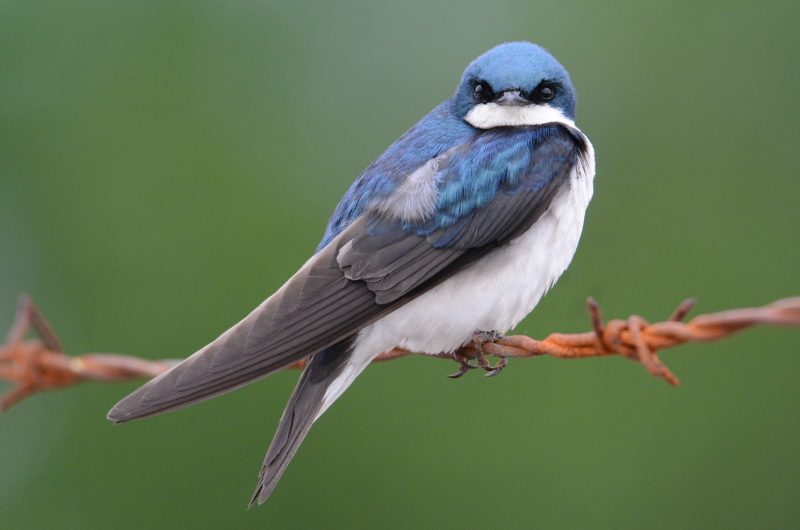
Tree Swallows are medium-sized migratory birds, roughly 5.5 to 6 inches long, with a wingspan around 12 inches. They are known for their striking iridescent blue-green upperparts that shimmer in the sunlight, contrasting sharply with their pristine white underparts. This color pattern makes them relatively easy to identify, especially during flight or when perched. Their slightly forked tails and streamlined bodies enhance their aerial agility.
These swallows are cavity nesters, preferring natural tree holes, abandoned woodpecker cavities, or artificial nest boxes placed near lakes, ponds, and wetlands. Tennessee provides ideal breeding grounds with its abundant wetlands and open woodlands. During the breeding season, Tree Swallows aggressively defend their nesting sites, often competing with other cavity nesters such as bluebirds.
Tree Swallows are expert aerial insect hunters, feeding primarily on flying insects like flies, mosquitoes, and moths. Their flight is buoyant and graceful, often gliding on air currents and darting rapidly to snatch prey midair. Outside of the breeding season, they may also consume berries and seeds, especially during migration and winter months.
In Tennessee, Tree Swallows are seasonal visitors, arriving in spring to breed and departing in late summer or early fall to winter in the southern United States or Central America. They favor open habitats near water, including marshes, fields, and lakeshores, where insect populations flourish. Their presence is an important indicator of wetland health and insect availability.
Purple Martin
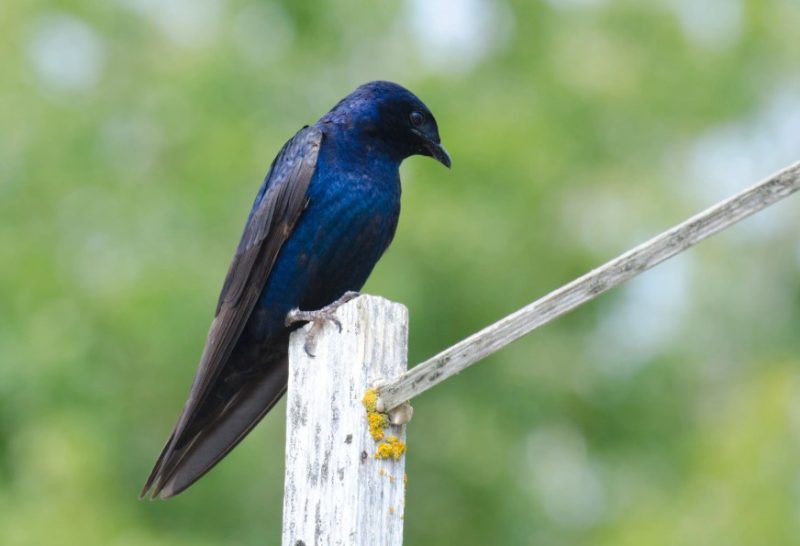
Purple Martins are the largest swallows found in North America, measuring about 7 to 8 inches long with a wingspan approaching 15 inches. Adult males display a stunning glossy, dark purple-blue plumage that appears almost black in certain lighting, while females and juveniles have a more muted grayish-blue coloration with lighter underparts. Their robust size and iridescent sheen make them unmistakable among swallow species.
Highly social birds, Purple Martins nest in large colonies, relying almost exclusively on man-made housing such as birdhouses and gourds in Tennessee. These artificial nesting sites are often clustered near water bodies and open fields, which provide plentiful flying insects like dragonflies, beetles, and wasps for food. Martins exhibit cooperative breeding behaviors and vocalize with a variety of melodious chirps and warbles.
Their foraging strategy is characterized by fast, soaring flight over open spaces, where they catch insects in midair with impressive speed and agility. Purple Martins play a critical role in controlling insect populations, benefiting both natural ecosystems and human communities. They are popular among bird enthusiasts, who often maintain martin houses to encourage their presence.
In Tennessee, Purple Martins arrive in spring and remain through summer as they breed and raise their young. Migration south begins in late summer or early fall. Their dependence on human-provided nesting sites means their distribution is closely linked to where people maintain suitable housing. Conservation efforts help maintain their populations, which face pressures from habitat loss and competition with invasive species.
Cliff Swallow
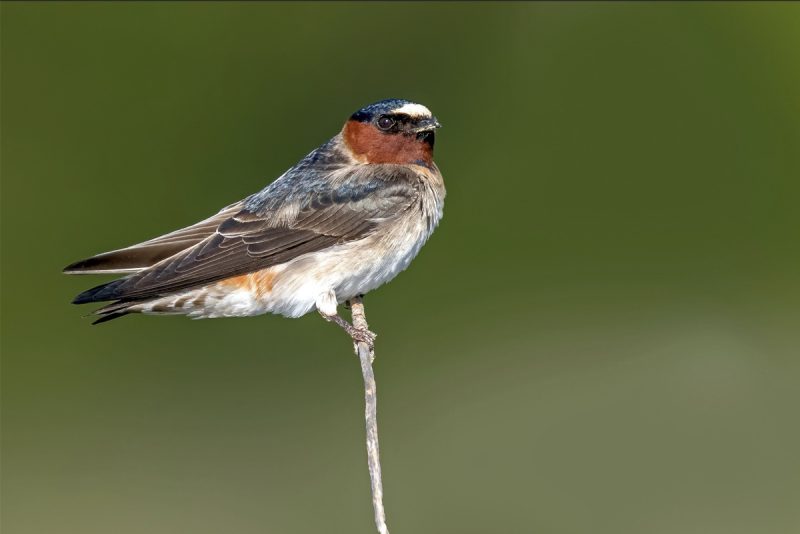
Cliff Swallows are medium-sized birds measuring approximately 5 to 6 inches in length with a wingspan around 11 inches. They are easily distinguished by their square tails, pale buff-colored throat and underparts, and a prominent pale forehead patch contrasting with dark brown upperparts. Their sturdy, stocky build supports their unique nesting behavior.
This species is famous for its distinctive gourd-shaped mud nests, which they build in dense colonies on vertical surfaces such as cliffs, bridges, and the eaves of buildings. In Tennessee, these colonial nests can often be found under highway overpasses and river bridges. The nests are made from thousands of tiny mud pellets, carefully constructed by both males and females, sometimes forming large clusters housing dozens of pairs.
Cliff Swallows are insectivorous, feeding mainly on flying insects caught during fast, erratic flights over open fields, wetlands, and rivers. They often forage in large groups, sometimes mixing with other swallow species, and can be seen performing impressive aerial maneuvers to capture prey. Their vocalizations are a series of harsh, chattering calls used to communicate within the colony.
During the summer months, Cliff Swallows are common breeders in Tennessee, arriving in late spring and departing in early fall for wintering grounds in the southern United States and Central America. Their preference for nesting on man-made structures has allowed them to adapt well to human-altered landscapes, although they are sensitive to disturbance during nesting. Their social nature and striking mud nests make them a fascinating species for bird watchers.
Bank Swallow
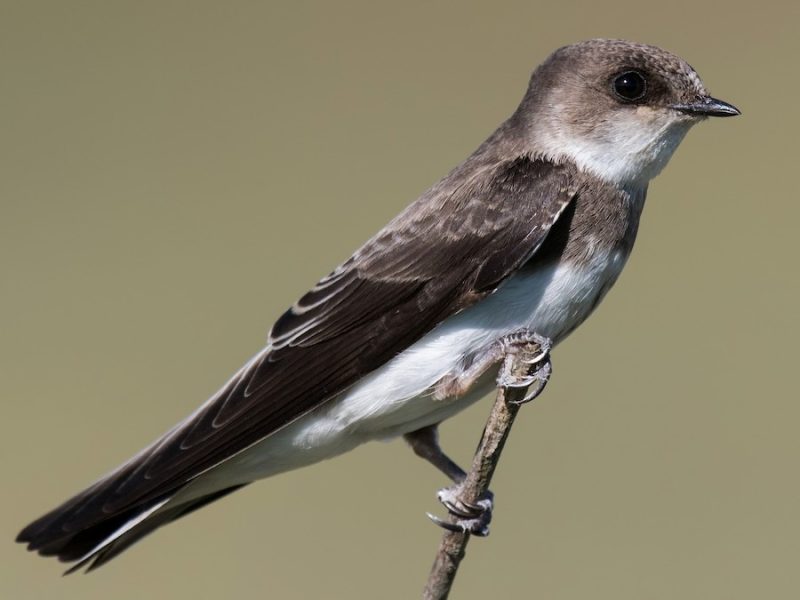
The Bank Swallow is a small and slender swallow, measuring about 4.5 to 5 inches in length with a wingspan of approximately 10 to 11 inches. It is easily identifiable by its brown upperparts and clean white underparts, highlighted by a distinctive narrow brown band across the breast. This subtle but clear chest band sets it apart from other swallow species in Tennessee. The overall coloration provides excellent camouflage against the earthy backgrounds where they nest.
Bank Swallows are unique in their nesting habits; they excavate burrows in vertical sandy or earthen banks found along rivers, streams, lakeshores, or sand pits. These nests are tunnels dug into the soil where they lay eggs and rear their young safely away from many predators. The nesting colonies can be quite large, sometimes consisting of hundreds of pairs. This social nesting behavior is an adaptation that offers increased protection through numbers.
In Tennessee, Bank Swallows are typically present from spring through summer, arriving during their northward migration to breed. They favor habitats near water bodies with exposed soil banks, making river edges, quarry sites, and road cuts ideal nesting locations. During the non-breeding season, they migrate south to warmer regions in Central and South America.
Feeding primarily on flying insects, Bank Swallows are agile fliers that capture their prey on the wing. They hunt over open areas such as fields and water surfaces, feeding on flies, beetles, and other small insects. Their quick, darting flight pattern and frequent vocalizations make them noticeable, though their small size sometimes causes them to be overlooked.
Rough-winged Swallow
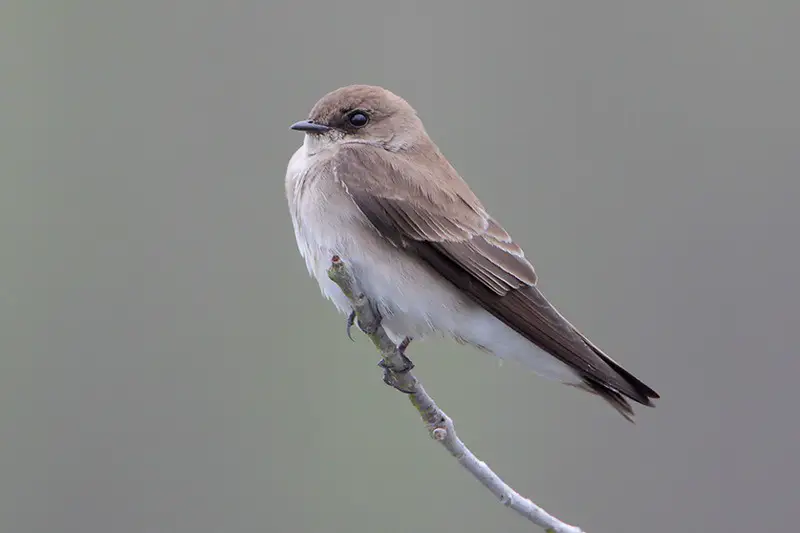
The Rough-winged Swallow is a modestly colored swallow species, measuring roughly 5 to 6 inches in length with a wingspan of about 11 inches. Unlike the more vividly colored swallows, it displays a plain brown back and pale underparts, lacking the glossy or iridescent hues typical of its relatives. One distinctive feature giving this species its name is the presence of small, rough-edged feathers on the leading edge of its wings, which can sometimes be felt during handling but are hard to see in the wild.
This swallow is a cavity nester, often using natural crevices in riverbanks, rock ledges, or burrows abandoned by other animals for nesting. Rough-winged Swallows dig or adopt tunnels in earthen banks, or use cavities in stone walls and cliffs, sometimes nesting solitarily or in loose colonies. In Tennessee, they can be found in a variety of habitats but prefer areas near streams and rivers where suitable nesting sites are available.
Behaviorally, Rough-winged Swallows are less conspicuous than other swallow species due to their dull coloration and quieter vocalizations. They forage alone or in small groups, flying low over water or open ground to catch insects such as flies, wasps, and moths. Their flight is direct but less acrobatic compared to more colorful swallows, reflecting their more understated nature.
During the breeding season, Rough-winged Swallows are common residents across Tennessee from spring to late summer. They migrate southward for the winter to warmer climates in Central and South America. Their ability to nest in less obvious locations and their discreet plumage make them a species that often goes unnoticed despite being fairly widespread throughout the state.
FAQ about Swallows and Martins in Tennessee
What species of swallows and martins are commonly found in Tennessee?
Tennessee is home to several species of swallows and martins, including the Barn Swallow, Tree Swallow, Purple Martin, Cliff Swallow, Bank Swallow, and Rough-winged Swallow. Each species has distinct characteristics and habitat preferences but are all commonly seen during the spring and summer months.
When do swallows and martins arrive in Tennessee?
Most swallows and martins migrate to Tennessee in early spring, typically between March and April. They stay through the breeding season and begin migrating south again in late summer or early fall, usually around August or September.
Where do swallows and martins typically nest in Tennessee?
Swallows and martins choose a variety of nesting sites in Tennessee. Barn Swallows build mud cup nests on man-made structures like barns and bridges. Purple Martins rely heavily on birdhouses or gourds provided by humans. Cliff Swallows construct mud nests in colonies under bridges or cliffs, while Bank and Rough-winged Swallows nest in tunnels burrowed into riverbanks, sandbanks, or cliffs.
What do swallows and martins eat?
Swallows and martins primarily feed on flying insects such as flies, beetles, wasps, mosquitoes, and moths. They are agile fliers, catching their prey mid-air during swift and acrobatic flights over open fields, wetlands, and water bodies.
How can I attract swallows and martins to my yard in Tennessee?
To attract Purple Martins, setting up proper birdhouses or gourds in open areas near water is effective. Providing nest boxes can also encourage Tree Swallows and other cavity nesters. Maintaining a pesticide-free environment helps increase insect availability, which is essential for feeding these birds.
Are swallows and martins beneficial for the environment?
Yes, swallows and martins are excellent natural pest controllers. By consuming large quantities of flying insects, they help reduce populations of mosquitoes and agricultural pests, contributing positively to the ecosystem and human well-being.
Do swallows and martins face any threats in Tennessee?
Swallows and martins face threats from habitat loss, especially the reduction of suitable nesting sites. Purple Martins depend heavily on human-provided nesting houses, so a lack of maintenance can impact their populations. Pesticide use also reduces insect prey availability, which can affect their survival and reproductive success.






